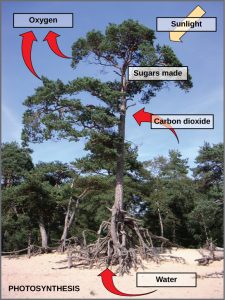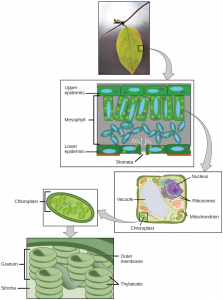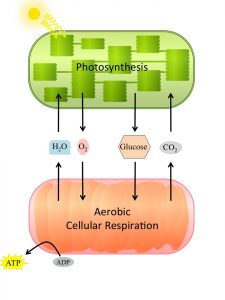5 Energy Flow through Ecosystems
Learning Objectives
After studying this chapter, you should be able to:
- List the levels of organization of living things in the environment
- Differentiate between food chains and food webs
- Describe how organisms acquire energy in a food web and in associated food chains
- Explain how the efficiency of energy transfers between trophic levels affects ecosystem
- Describe the overall process of cellular respiration
- Describe the overall process of photosynthesis
Levels of Organization in the Environment
Living things and the environments in which they live are highly organized and structured, following a hierarchy on a scale from small to large (Figure 1). Organisms are individual living entities. For example, antelope on an African savanna is an organism. All the individuals of one species living within a specific area are collectively called a population. For example, a savanna may be home to many antelopes. All of these antelopes represent the population of antelopes in this area. Different populations may live in the same specific area. For example, the savanna with the antelopes includes populations of trees and also insects and microbial populations.
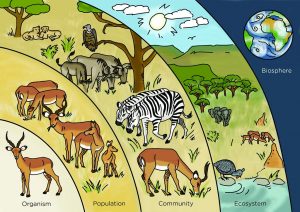
A community is all the populations inhabiting a particular area. For instance, all of the antelopes, lions, vultures, insects, and other populations in a savanna form the savanna’s community. The savanna itself is an ecosystem. An ecosystem consists of all the biotic, or living, things in a particular area together with the abiotic, or non-living, parts of that environment such as nitrogen in the soil or rainwater. At the highest level of organization, the biosphere is the collection of all ecosystems, and it represents the zones of life on Earth. It includes land, water, and portions of the atmosphere.
Ecosystems can be small, such as the tide pools found near the rocky shores of many oceans, or large, such as those found in the tropical rainforest of the Amazon in Brazil (Figure 2).
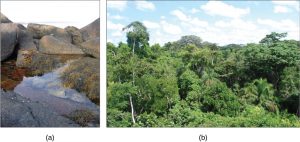
Ecology of Ecosystems
Life in an ecosystem often involves competition for limited resources, which occurs both within a single species and between different species. Organisms compete for food, water, sunlight, space, and mineral nutrients. These resources provide the energy for metabolic processes and the matter to make up organisms’ physical structures. Other critical factors influencing community dynamics are the components of its physical environment: a habitat’s climate (seasons, sunlight, and rainfall), elevation, and geology. These can all be important environmental variables that determine which organisms can exist within a particular area.
There are three broad categories of ecosystems based on their general environment: freshwater, marine, and terrestrial. Within these three categories are individual ecosystem types based on the environmental habitat and organisms present.
Freshwater ecosystems are the least common, occurring on only 1.8 percent of Earth’s surface. These systems comprise lakes, rivers, streams, and springs; they are quite diverse, and support a variety of animals, plants, fungi, protists and prokaryotes.
Marine ecosystems are the most common, comprising 75 percent of Earth’s surface and consisting of three basic types: shallow ocean, deep ocean water, and deep ocean bottom. Shallow ocean ecosystems include extremely biodiverse coral reef ecosystems, yet the deep ocean water is known for large numbers of plankton and krill (small crustaceans) that support it. These two environments are especially important to aerobic respirators worldwide, as the phytoplankton perform 40 percent of all photosynthesis on Earth. Although not as diverse as the other two, deep ocean bottom ecosystems contain a wide variety of marine organisms. Such ecosystems exist even at depths where light is unable to penetrate through the water.
Terrestrial ecosystems, also known for their diversity, are grouped into large categories called biomes. A biome is a large-scale community of organisms, primarily defined on land by the dominant plant types that exist in geographic regions of the planet with similar climatic conditions. Examples of biomes include tropical rainforests, savannas, deserts, grasslands, temperate forests, and tundras. Grouping these ecosystems into just a few biome categories obscures the great diversity of the individual ecosystems within them. For example, the saguaro cacti (Carnegiea gigantea) and other plant life in the Sonoran Desert, in the United States, are relatively diverse compared with the desolate rocky desert of Boa Vista, an island off the coast of Western Africa (Figure 3).
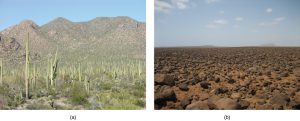
Food Chains and Food Webs
A food chain is a linear sequence of organisms through which nutrients and energy pass as one organism eats another (Figure 4). Each organism in a food chain occupies a specific trophic level (energy level), its position in the food chain or food web. The trophic levels in the food chain are producers, primary consumers, and higher-level consumers. These levels are used to describe ecosystem structure and dynamics. There is a single path through a food chain.
In many ecosystems, the base, or foundation, of the food chain consists of photosynthetic organisms (plants or phytoplankton), which are called producers. The organisms that consume the producers are herbivores: the primary consumers. Secondary consumers are usually carnivores that eat the primary consumers. Tertiary consumers are carnivores that eat other carnivores. In some ecosystems, quaternary consumers eat tertiary consumers. Higher-level consumers feed on the next lower trophic levels, and so on, up to the organisms at the top of the food chain: the apex consumers, or apex predators. An apex predator is a species that is not eaten by any other consumers. In the Lake Ontario food chain, shown in Figure 4, the Chinook salmon is the apex consumer at the top of this food chain.
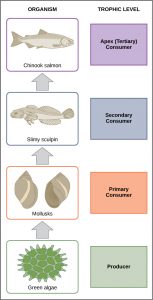
One major factor that limits the number of steps in a food chain is energy. Energy is lost at each trophic level and between trophic levels as heat and in the transfer to decomposers (Figure 5). In general, about 10% of the energy from one trophic level passes to the next trophic level. Thus, after a limited number of trophic energy transfers, the amount of energy remaining in the food chain may not be great enough to support viable populations at yet a higher trophic level.
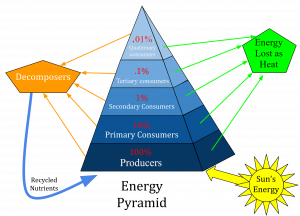
There is one problem when using food chains to describe most ecosystems. Even when all organisms are grouped into appropriate trophic levels, some of these organisms can feed on more than one trophic level; likewise, some of these organisms can also be fed on from multiple trophic levels. In addition, species feed on and are eaten by more than one species. In other words, the linear model of ecosystems, the food chain, is a hypothetical, overly simplistic representation of ecosystem structure. A holistic model—which includes all the interactions between different species and their complex interconnected relationships with each other and with the environment—is a more accurate and descriptive model for ecosystems.
A food web is a concept that accounts for the multiple trophic (feeding) interactions between each species and the many species it may feed on, or that feed on it. In a food web, the several trophic connections between each species and the other species that interact with it may cross multiple trophic levels. The matter and energy movements of virtually all ecosystems are more accurately described by food webs (Figure 6).
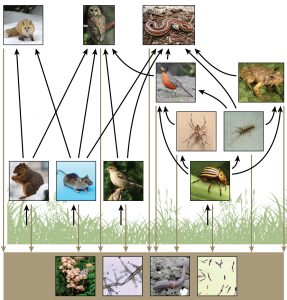
Two general types of food webs are often shown interacting within a single ecosystem. A grazing food web has plants or other photosynthetic organisms at its base, followed by herbivores and various carnivores. A detrital food web consists of a base of organisms that feed on decaying organic matter (dead organisms), including decomposers (which break down dead and decaying organisms) and detritivores (which consume organic detritus). These organisms are usually bacteria, fungi, and invertebrate animals that recycle organic material back into the biotic part of the ecosystem as they themselves are consumed by other organisms. As ecosystems require a method to recycle material from dead organisms, grazing food webs have an associated detrital food web. For example, in a meadow ecosystem, plants may support a grazing food web of different organisms, primary and other levels of consumers, while at the same time supporting a detrital food web of bacteria and fungi feeding off dead plants and animals. Simultaneously, a detrital food web can contribute energy to a grazing food web, as when a robin eats an earthworm.
Knowledge Check
How Organisms Acquire Energy in a Food Web
All living things require energy in one form or another. Energy is used by most complex metabolic pathways, especially those responsible for building large molecules from smaller compounds. Living organisms would not be able to assemble complex molecules (proteins, lipids, nucleic acids, and complex carbohydrates) from their building blocks without a constant energy input.
Food-web diagrams illustrate how energy flows directionally through ecosystems. They can also indicate how efficiently organisms acquire energy, use it, and how much remains for use by other organisms of the food web.
An autotroph is an organism that can produce its own food. The Greek roots of the word autotroph mean “self” (auto) “feeder” (troph). Plants are the best-known autotrophs, but others exist, including certain types of bacteria and algae (Figure 7). Oceanic algae contribute enormous quantities of food and oxygen to global food chains. Plants are technically photoautotrophs, a type of autotroph that uses sunlight and carbon from carbon dioxide to synthesize chemical energy in the form of carbohydrates using the process of photosynthesis. All organisms carrying out photosynthesis require sunlight.

Heterotrophs are organisms incapable of photosynthesis that must therefore obtain energy and carbon from food by consuming other organisms. The Greek roots of the word heterotroph mean “other” (hetero) “feeder” (troph), meaning that their food comes from other organisms. Even if the food organism is another animal, this food traces its origins back to autotrophs and the process of photosynthesis. Humans are heterotrophs, as are all animals. Heterotrophs depend on autotrophs, either directly or indirectly. Deer and wolves are heterotrophs. A deer obtains energy by eating plants. A wolf eating a deer obtains energy that originally came from the plants eaten by that deer. The energy in the plant came from photosynthesis, and therefore it is the only autotroph in this example (Figure 8). Using this reasoning, all food eaten by humans also links back to autotrophs that carry out photosynthesis.
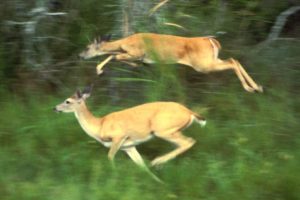
Consequences of Food Webs: Biomagnification
One of the most important consequences of ecosystem dynamics in terms of human impact is biomagnification. Biomagnification, also known as bioaccumulation, is the increasing concentration of persistent, toxic substances in organisms at each successive trophic level. These are substances that are fat soluble, not water soluble, and are stored in the fat reserves of each organism. Many substances have been shown to biomagnify, including classical studies with the pesticide dichlorodiphenyltrichloroethane (DDT), which were described in the 1960s bestseller, Silent Spring by Rachel Carson. DDT was a commonly used pesticide before its dangers to apex consumers, such as the bald eagle, became known. In aquatic ecosystems, organisms from each trophic level consumed many organisms in the lower level, which caused DDT to increase in birds (apex consumers) that ate fish. Thus, the birds accumulated sufficient amounts of DDT to cause fragility in their eggshells. This effect increased egg breakage during nesting and was shown to have devastating effects on these bird populations. The use of DDT was banned in the United States in the 1970s.
Other substances that biomagnify are polychlorinated biphenyls (PCBs), which were used as coolant liquids in the United States until their use was banned in 1979, and heavy metals, such as mercury, lead, and cadmium. These substances are best studied in aquatic ecosystems, where predatory fish species accumulate very high concentrations of toxic substances that are at quite low concentrations in the environment and in producers. As illustrated in a study performed by the NOAA in the Saginaw Bay of Lake Huron of the North American Great Lakes (Figure 9), PCB concentrations increased from the producers of the ecosystem (phytoplankton) through the different trophic levels of fish species. The apex consumer, the walleye, has more than four times the amount of PCBs compared to phytoplankton. Also, based on results from other studies, birds that eat these fish may have PCB levels at least one order of magnitude higher than those found in the lake fish.
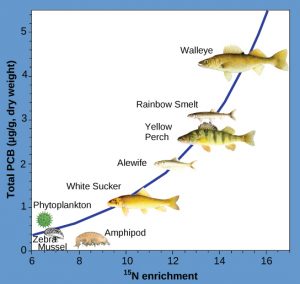
Other concerns have been raised by the biomagnification of heavy metals, such as mercury and cadmium, in certain types of seafood. The United States Environmental Protection Agency (EPA) recommends that pregnant women and young children should not consume any swordfish, shark, king mackerel, or tilefish because of their high mercury content. If they choose to eat fish, these individuals are advised to eat those lower in mercury: salmon, shrimp, pollock, and catfish. Biomagnification is a good example of how ecosystem dynamics can affect our everyday lives, even influencing the food we eat.
Photosynthesis
Media Attributions
- Levels_of_organization © Siyavula Education is licensed under a CC BY (Attribution) license
- Tide pool and Amazon rainforest © Jim Kuhn; Ivan Mlinaric adapted by OpenStax is licensed under a CC BY (Attribution) license
- Deserts © Jay Galvin; Ingo Wölbern adapted by OpenStax is licensed under a CC BY (Attribution) license
- Food chain trophic levels © NOAA is licensed under a Public Domain license
- Energy Pyramid © Epipelagic adapted by Sean Whitcomb is licensed under a CC BY-SA (Attribution ShareAlike) license
- Food_web © "fox": modification of work by Kevin Bacher, NPS; "owl": modification of work by John and Karen Hollingsworth, USFWS; "snake": modification of work by Steve Jurvetson; "robin": modification of work by Alan Vernon; "frog": modification of work by Alessandro Catenazzi;"spider": modification of work by "Sanba38"/Wikimedia Commons; "centipede": modification of work by “Bauerph”/Wikimedia Commons;"squirrel": modification of work by Dawn Huczek; "mouse": modification of work by NIGMS, NIH; "sparrow": modification of work by David Friel; "beetle": modification of work by Scott Bauer, USDA Agricultural Research Service; "mushrooms": modification of work by Chris Wee; "mold": modification of work by Dr. Lucille Georg, CDC; "earthworm": modification of work by Rob Hille; "bacteria": modification of work by Don Stalons, CDC adapted by OpenStax is licensed under a CC BY (Attribution) license
- Autotrophs © Steve Hillebrand (US FWS); NASA is licensed under a CC BY (Attribution) license
- Deer © Steve VanRiper, U.S. Fish and Wildlife Service is licensed under a Public Domain license
- Bioaccumulation
- Photosynthesis illustration is licensed under a CC BY (Attribution) license
- Leaf_structure © Cory Zanker adapted by OpenStax is licensed under a CC BY (Attribution) license
- Photosynthesis respiration relationship © Eva Horne and Robert Bear (used with permission) is licensed under a CC BY (Attribution) license

